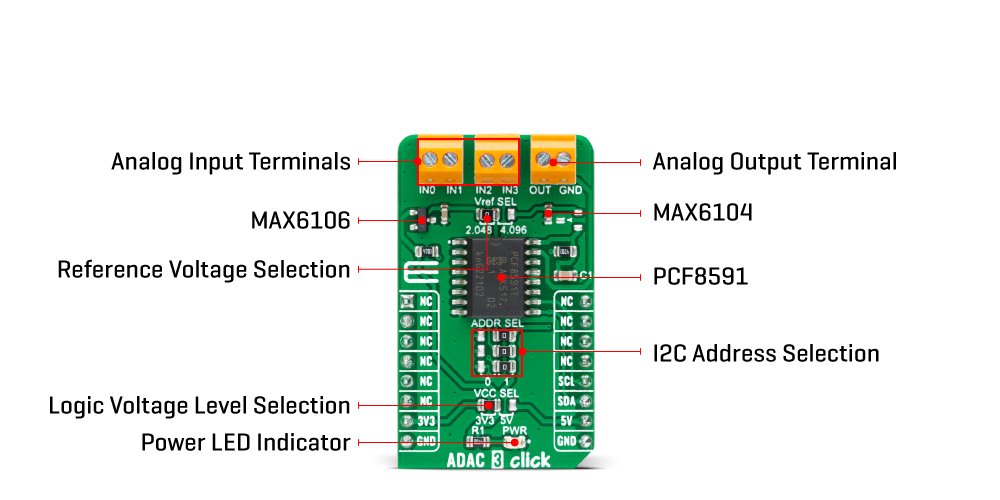






Key Features
Overview
The ADAC 3 Click Board™ is a compact add-on board representing the ADC/DAC combo solution. This board features the PCF8591, a low-power 8-bit CMOS data acquisition device with four analogue inputs, one analogue output, and a serial I2C interface from NXP Semiconductors. The PCF8591 includes analogue input multiplexing, an on-chip track and hold function and 8-bit analogue-to-digital conversion alongside an 8-bit digital-to-analogue conversion. In addition, the user is given the option to select the PCF8591 reference voltage value, choosing between 2,048 and 4,096V. This Click board™ is suitable for various control, monitoring, or measurement applications such as supply monitoring, reference setting, analogue control loops, and more.
The ADAC 3 Click Board™ is supported by a mikroSDK compliant library, which includes functions that simplify software development. This Click board™ comes as a fully tested product, ready to be used on a system equipped with the mikroBUS™ socket.
Downloads
How Does The ADAC 3 Click Board™ Work?
The ADAC 3 Click Board™ as its foundation uses the PCF8591, a low-power CMOS data acquisition device from NXP Semiconductors. The PCF8591 comes with four analog inputs configurable as single-ended or differential inputs used to measure voltages, alongside one analog output representing an 8-bit digital-to-analog converter. In addition to measuring voltage, the user can create them as desired and even use DAC and ADC together to generate an input to a circuit and measure the results with the ADC, making it suitable for various control, monitoring, or measurement applications. By its internal structure, the PCF8591 also consists of an analog input multiplexing circuit, an on-chip track and hold function, alongside a serial interface block.

The ADAC 3 Click Board™ communicates with MCU using the standard I2C 2-Wire interface with a maximum clock frequency of 100kHz. The PCF8591 has a 7-bit slave address with the first four MSBs fixed to 1001. The address pins A0, A1, and A2, are programmed by the user and determine the value of the last three LSBs of the slave address, which can be selected by positioning onboard SMD jumpers labelled as ADDR SEL to an appropriate position marked as 0 or 1.
Besides, the user can choose the PCF8591 reference voltage value by positioning the SMD jumper labelled VREF SEL to a proper position, choosing between 2,048 and 4,096V provided by MAX6104 and MAX6106.
The ADAC 3 Click Board™ can operate with both 3.3V and 5V logic voltage levels selected via the VCC SEL jumper. This way, it is allowed for both 3.3V and 5V capable MCUs to use the communication lines properly. However, the Click board™ comes equipped with a library containing easy-to-use functions and an example code that can be used, as a reference, for further development.
SPECIFICATIONS
| Type | ADC-DAC |
| Applications | Can be used for various control, monitoring, or measurement applications |
| On-board modules | PCF8591 - low-power CMOS data acquisition device from NXP Semiconductors |
| Key Features | Low power consumption, combo solution with four analog inputs and one analog output, 8-bit successive approximation A/D conversion, I2C serial interface, analog inputs configurable as single ended or differential inputs, on-chip track and hold circuit, and more |
| Interface | I2C |
| Compatibility | mikroBUS |
| Click board size | M (42.9 x 25.4 mm) |
| Input Voltage | 3.3V or 5V |
PINOUT DIAGRAM
This table shows how the pinout of the ADAC 3 Click Board™ corresponds to the pinout on the mikroBUS™ socket (the latter shown in the two middle columns).
| Notes | Pin |  |
Pin | Notes | |||
|---|---|---|---|---|---|---|---|
| NC | 1 | AN | PWM | 16 | NC | ||
| NC | 2 | RST | INT | 15 | NC | ||
| NC | 3 | CS | RX | 14 | NC | ||
| NC | 4 | SCK | TX | 13 | NC | ||
| NC | 5 | MISO | SCL | 12 | SCL | I2C Clock | |
| NC | 6 | MOSI | SDA | 11 | SDA | I2C Data | |
| Power Supply | 3.3V | 7 | 3.3V | 5V | 10 | 5V | Power Supply |
| Ground | GND | 8 | GND | GND | 9 | GND | Ground |
ONBOARD SETTINGS AND INDICATORS
| Label | Name | Default | Description |
|---|---|---|---|
| LD1 | PWR | - | Power LED Indicator |
| JP1 | VCC SEL | Left | Logic Level Voltage Selection 3V3/5V: Left position 3V3, Right position 5V |
| JP2-JP4 | ADDR SEL | Right | I2C Address Selection 0/1: Left position 0, Right position 1 |
| JP5 | VREF SEL | Left | Reference Voltage Selection 2.048/4.096: Left position 2.048, Right position 4.096 |
ADAC 3 CLICK ELECTRICAL SPECIFICATIONS
| Description | Min | Typ | Max | Unit |
|---|---|---|---|---|
| Supply Voltage | 3.3 | - | 5 | V |
| Analog Input Voltage | 0 | - | 5 | V |
| Analog Output Voltage | 0 | - | 5 | V |
| Resolution | - | 8 | - | bit |
| Operating Temperature Range | -40 | +25 | +85 | °C |
| General Information | |
|---|---|
Part Number (SKU) |
MIKROE-5198
|
Manufacturer |
|
| Physical and Mechanical | |
Weight |
0.02 kg
|
| Other | |
Country of Origin |
|
HS Code Customs Tariff code
|
|
EAN |
8606027388330
|
Warranty |
|
Frequently Asked Questions
Have a Question?
Be the first to ask a question about this.







